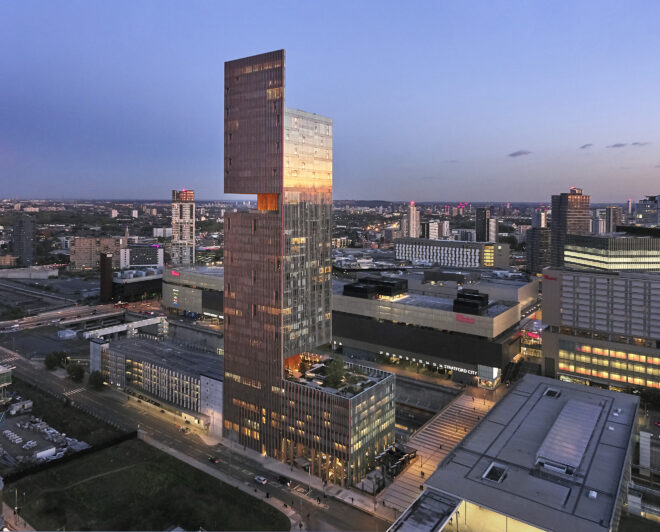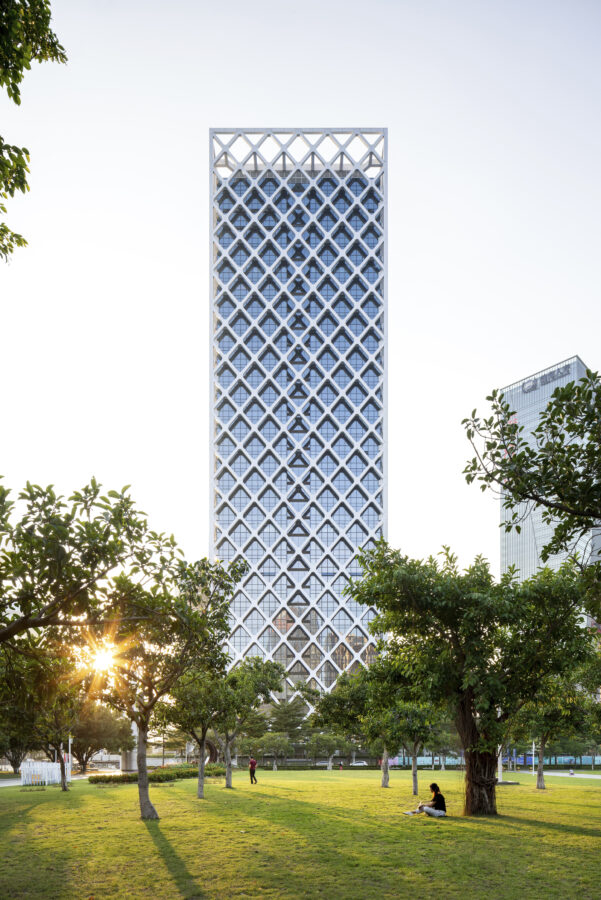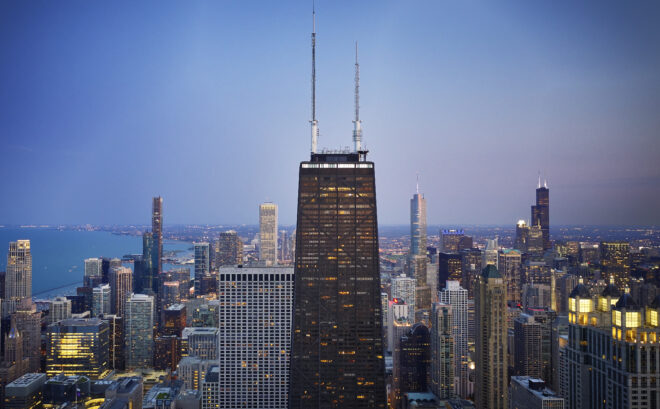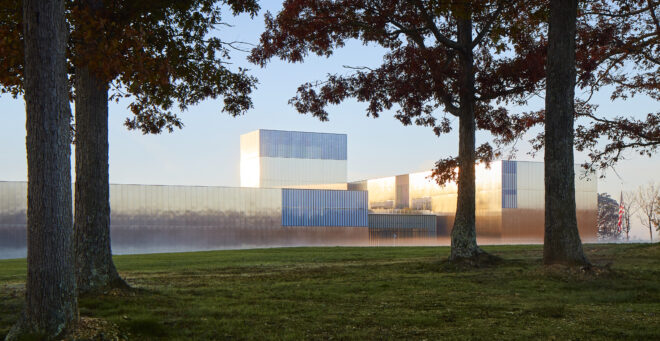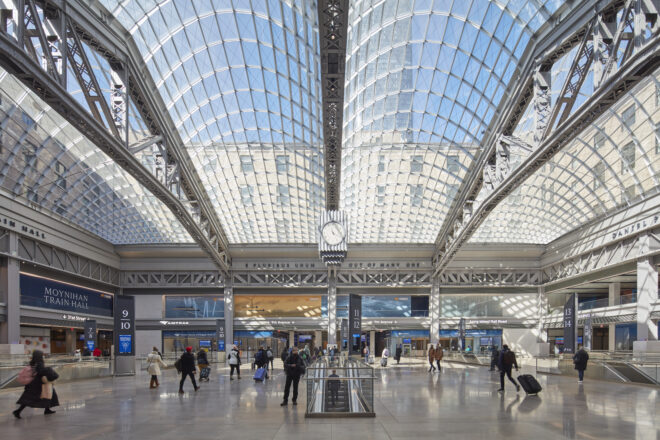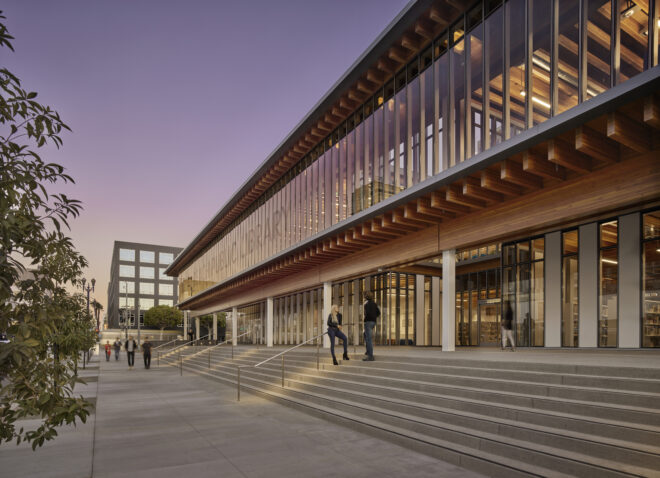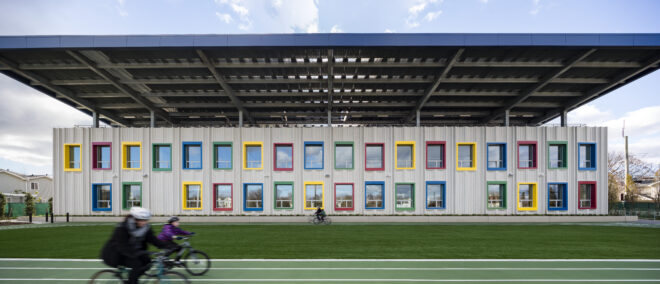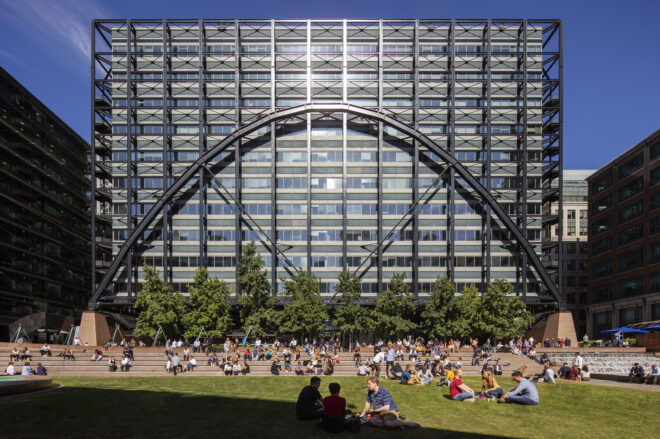Branding and marketing are the key features in leading a successful architecture firm although it is not a topic that is often discussed in our profession. Starting a practice is like setting up a business; without basic knowledge of marketing, industry architects fall short in promoting their business. An understanding of the importance of brand building and brand differentiation can become a key element in building a well-known, recognised and liked practice.
Finn MacLeod, a design communications expert with a background in architectural journalism, history, and theory, discusses the value of brand differentiation for architects and designers in this fast-paced industry. With an experience of 10 years in the architecture industry working alongside big-name companies like OMA and ArchDaily, Finn is now the associate, and assistant head of global communications for Skidmore, Owings & Merrill or more popularly known as SOM. He is responsible for heading SOM’s Global Communications team and essentially wrapping his hand around the entire world by communicating with experts at offices in 12 different cities to run the social media, PR campaigns, photography, and content.
Project Name: Manhattan Loft Gardens
Photographer/Artist: Hufton + Crow
Copyright: © Hufton + Crow
SOM is an 86 years old architectural firm founded in 1936 by architects Louis Skidmore and Nathaniel Owings, later joined by engineer John Merrill in 1939. Over the span of more than 8 decades, SOM has gained a reputation that precedes itself. With a portfolio of over 10,000 projects spanned across the world in 50 countries with a team of 1200+ members, it has become one of the long-standing companies leading the excellence in architecture with 2500+ design awards. SOM has been the designer of many monumental projects like John Hancock Center, Chase Tower, Burj Khalifa, One World Trade Center, and Moynihan Train Hall; varying in scale and complexity. Design excellence has been a pillar of SOM and a consistent driving force for the company. Finn describes branding as a highly complicated exercise for the storyteller to knit all of it together under one company; he understands that SOM needs to evolve with time and accept the change as a part of the growth of the company.
Project Name: Shenzhen Rural Commercial Bank Headquarters
Photographer/Artist: Seth Powers
Copyright: © Seth Powers
Working on the campaign for Fondazione Prada Torre with OMA as his last project and immediately starting with the campaign of NATO Headquarters as his first project with SOM, Finn drew a comparison between the two:
“Between these two projects, across two different firms in this vast spectrum of needs I learned a lot in terms of what communicating a project is.”- Finn MacLeod
His knowledge of brand building in the architecture industry has led to creating a list of tips that designers can use in their practice. This was presented by Finn online in the Disrupt Symposium hosted by Sara Kolata, an architect, and a digital transformation expert.
Disrupt Symposium is the first of its kind Business of Architecture event bringing to stage C-level directors and leaders of key architecture and engineering practices.
Our goal is to uncover topics which until now, have been taboo in our industry. On our stage, we ask questions related to practice operations and patterns of success in Architecture. Due to the fact that business is not commonly covered in the architecture school curriculum, many architects start their careers with next to no business acumen. Unless you were able to watch your parents be tenacious business owners or had another role model, you most likely will find yourself stalled when entering the world of business.
So, how can we ensure that each and every one of us has an equal opportunity in starting our own practice?
We can do that through learning from experts, globally. After all, there are many individuals whose everyday decisions drive the success of the practices we follow and admire. Disrupt Symposium looks for those amazing business-minded people in leadership roles and brings them to the stage for exclusive series of presentations.
In our events it’s all about the attendees, therefore each and every one of you has an opportunity to personally interact with our speakers through a live Q&A session.
You can also get access to session recordings and be a part of our educational newsletter. So, join us today by getting your ticket to the next event planned for 1-3rd Nov 2022. www.disruptsymposium.com
This upcoming edition welcomes to stage UnStudio, Grimshaw, Herzog de Meuron, HKS, HOK, Mace, OfficeUntitled, K-Studio and Archi-Tectonics.
In the May edition of Disrupt Symposium 2022, Finn MacLeod presented the topic discussed in this article. One of the first things that Finn talked about is the scaling of PR, which varies depending on the brand. The presentation given by Finn covered these four major elements– why brand building matters, how one can do it, what is the starting point for a brand and the most essential part is measuring success.
Keep reading to learn more.
Project Name: 875 North Michigan Avenue (formerly John Hancock Center)
Photographer/Artist: Dave Burk
Copyright: © SOM
Why it matters?
“Brand really is everything”
Finn puts it very plainly about how a brand transects everything that a company does and builds a perception of people.
“What people can see of you is your brand, is your reputation. This cannot be understated enough how much this needs to be considered in a multifaceted way.”
The most essential piece of conversation is knowing that it can bring in new work; another one is to connect with the students and upcoming professionals in the industry who can later on become a part of the company.
“Knowing what the firm represents and reinforcing the design expertise is one of the parts of branding, along with expanding the horizons and trying to reach new audiences through their work.”
Finn, a communications expert emphasizes the topic of the Brand Ecosystem which is not well-known and understood by people outside the marketing industry. Several different elements contribute to the brands’ reputation which is often unacknowledged and unspoken of on a day-to-day basis. Websites, media coverage, awards, publication, photography, videography, and social media are the essential pieces in the design industry that contribute to the brand.
In a design space, websites and social media are the main sources of information for people outside the industry. A company’s presence on social media and word of mouth becomes an essential piece of brand perception. An architect’s understanding of a website is like a portfolio displaying all the work that is done, this makes it harder for the clients to understand the company. Instead, looking at a website as a brand tool as well as a business driver can prove more useful in making it easier for the potential client to grasp the essence of the firm.
Giving the example of SOM’s new website design carried out during the pandemic, Finn lays out the initial idea of looking at the website from a different perspective hence, hiring an agency that has not worked with architecture companies. This small idea allowed the company to look at its brand from the perception of a potential client and helped them in gaining a deeper understanding of the user experience. Another major tool that SOM used was producing the monograph of the company’s projects over the course of 10 years. This idea works well with an established company in starting a series of books that can leverage the brand. As Finn says, the existence of a book is branding in itself and over time it becomes an act of active branding.
Project Name: National Museum of the United States Army
Photographer/Artist: Dave Burk
Copyright: © SOM
Mass media is one of the easiest, most visible, and most straightforward ways of branding. This provides a good sense and a visual perspective of what works in the media. For example, investing in photography is very crucial as it is one of the ways to get featured on a magazine cover. Working outside the design magazines and websites is the way to appear where the potential clients are engaging. The process from drafting to publishing might take up your time but ensures the visibility of the brand outside the design space. Although maintaining a presence in the design media is important, active branding in industry magazines is equally important to appeal to peers. Active participation of the architect or the brand in daily discussions of the design industry is necessary to build a brand that has an opinion and is a part of ongoing conversations. Using this idea in practice at SOM, Finn details how the firm talked about a story that displayed all the female executive leadership team, which was a first in the management department, and later on, attended a podcast on a similar topic of leadership in the industry. Another major branding moment for SOM was the company’s appearance on Netflix’s “Getting Curious with Jonathan Van Ness.”
The key thing according to Finn MacLeod is to know that:
“Every firm has a brand – but not every firm builds and leverages it well.”
Project Name: Moynihan Train Hall
Photographer/Artist: Dave Burk
Copyright: © Empire State Development | SOM
How do you do it?
The overarching key points of the discussion to forming a concrete plan are defining the goals, a knowledge of the audience, clarity of value proposition, and establishing brand messaging. Before going into detail about the above-mentioned points, a firm needs to spell out the answers to these basic questions which will eventually give an understanding and direction for the future.
Defining the goals for a company comes in different forms in terms of growing the social media following, getting featured in the best magazines or websites, and branching out in another state or country likewise. With a list of predetermined goals and a timeline to achieve those goals, one can start with a marketing plan. To build an effective brand specificity plays a very important role.
Knowing the audience can be termed as one of the most essential parts of building the brand, this includes current clients, potential clients, and peers. Keeping current clients above potential clients works well as they are the ones paying at present and agreeing with the work of the brand, also highlighting the clients during promoting any project. At SOM, it is a part of their business planning process to know about the places that their clients are engaging and then later on target their promotions to those media outlets or media platforms. Another area of focus can be knowing about the new talents in the industry and potential employees. This builds up a strong employment front for the brand and helps in hiring the best possible candidates. A lesser discussed point yet a crucial one is keeping a good reputation with the competing brands or peers, as they are also a part of the brand’s reputation. A subset of the architecture community is the academic community nonetheless an important one as this group of people forms a key opinion group in architecture.
Clarifying the firm’s proposition starts with understanding the unique elements of the company and emphasizing them. For example, a cultural and civic design studio in Mexico City, net-zero residential design in Seattle, etc. A generic message of the brand does not contribute to its growth instead it puts it in a pile with similar brands.
According to Finn, establishing a brand messaging can be understood by laying out a brand purpose as described by Simon Sinek which focuses on these three questions: Why do you do what you do?… How do you do it?… Who do you do it for?…
Following this target board helps in telling an effective brand story. In architecture, this might look like a key design concept followed by the firm, how it was formed, and finally how it was executed.
Try to stay away from broad generic and overly esoteric branding and venture towards curated thoughtful design forward. Shifting the focus from being a business to being a design organization is the key part of branding.
Project Name: Moon Village
Copyright: © SOM | Slashcube GmbH
Where to start?
The important part is the alignment of the brand’s business goals and its brand strategy as discussed above. This proves to be extremely helpful under a strict timeline to streamline the campaign and not waste any time on something that the firm doesn’t want to associate with. Putting forward time in a strategic place is important when starting. The long-term goal of the brand should align with what the brand is currently promoting. How can one understand this? Finn details this under the subjects of knowing the ecosystem that one is part of, understanding the stock that the company has, getting the ducks in a row, and most important of all starting.
As mentioned previously the ecosystem comprises awards, publications, social media, etc. This manifests in different ways by creating thoughtfully curated content, celebrating the employees, exploring the design process, highlighting the unique client group, highlighting the culture, and differentiating the brand values from others. Finn compares a firm to an incubator of all these good ideas waiting to find the perfect platform where they can be displayed. This happens by identifying them and curating a branding strategy.
Understanding the stock of the company comes by answering a few questions: What are the firm’s brand strengths and weaknesses? What are the platforms that the brand is using and how effectively are they being used? Does the firm share the projects externally, or is it being promoted? Is the language used by the brand and ‘archispeak’, which is hard for the users and clients to understand?
How does one get their ducks in a row? To start, investment in a brand infrastructure is very crucial whether it is hiring a social media or PR expert, building or updating the company website, or getting the photography in order. The next step is knowing if outside help is required to get the job done effectively. Bringing a consultant for PR can save the brand from getting into any hot waters and generating a negative impression. Proper documentation of work is a key part of creating content for any platform like a website or a featured article. The company must have proper records of the work done and which can be displayed differently across platforms. The last requirement is to create social media accounts. Not all social media is created equal and to begin with, one can work on Instagram and LinkedIn, which are the platforms that generate huge traffic and have the highest daily user basis.
Don’t wait – Start now. Don’t overthink and wait too long instead start and then later experiment and learn as branding is a never-ending journey.
To give an understanding of the evolution of SOM Finn MacLeod talked about experimenting with a new series called 22 Questions, inspired by Vogue’s 73 questions. A walk-and-talk series around the office of SOM generated an enormous amount of traffic on Instagram by engaging with over 30,000+ accounts.
Project Name: Billie Jean King Main Library
Photographer/Artist: Benny Chan | Fotoworks
Copyright: © Benny Chan | Fotoworks
Measuring success?
After working on all the above-mentioned points, the most important part of growing is measuring success. In order to not waste the resources, the brand must define these points, when working with an agency: defining what success means to the brand, staying on the course, and being open-minded.
The definition of success differs from one brand to another but keeping a realistic goal will help in achieving it. The road to building a brand is long and staying on the course requires sticking to the brand strategy that is designed. Allow a little room to navigate in the designed course of actions which will change while keeping the message of the brand and its goals in place. Do not give up on this. Building a brand is like building a project, it takes effort over a period of time, and it takes a strong foundation and a team effort to execute.
Project Name: P.S. 62 The Kathleen Grimm School for Leadership and Sustainability at Sandy Ground
Photographer/Artist: James Ewing
Copyright: © James Ewing | OTTO
Strategies are constantly shifting and having the agility to change with them is the key. Instagram trends change on a weekly basis and knowing what is working at the moment is very important. Don’t be married to a particular idea or message; adapt, change and evolve. This involves redesigning the website every 3 to 5 years to keep up with the current trends. Invest in a consultant or an application to understand the trends on Instagram and to keep up with them. Lastly, keep up with the current discussions, and topics which are in the industry.
In concluding the presentation Finn summarized by mentioning a few points to take away:
- Seek out both mainstream media and design industry media coverage.
- Leverage various social media.
- Invest in high-quality photography and videography.
- Share ideas at events across industries.
- Submit the projects for awards that matter to your brand (project + culture)
- Employees are the best influencers – fold them into the brand
The Disrupt presentation in May 2022 was followed by a question-and-answer session where attendees had an interesting question pitched to Finn MacLeod. The discussion brought up several other points apart from the ones mentioned in the talk.
A newly established company might be unsure of the brand messaging that can focus on a niche and then evolve in the future and change it by expanding its horizons. When evolving the messaging, one must do it at a gradual pace and not appear as unstable. Architecture and design projects take up a huge amount of time from start to finish, so to maintain an active presence on social media the company lets the audience take a look at the construction phases and build a journey towards the polished end product. Along with that, the company can talk about its people, design strategy, opinions on industry topics, and likewise which are relevant to its brand.
Project Name: Broadgate Phase 11 – Exchange House
Photographer/Artist: Lucas Blair Simpson
Copyright: © SOM
It is important in architecture to be relatively consistent while introducing new topics which helps in building people’s trust and giving them an idea of what to expect from the brand. Maintain a sense of professionalism on the official pages of the brand on a different platform. This can be a burden on the company owner hence, hiring an intern to maintain the voice of the brand and its message can make it effective and less worrying for just one person to take care of everything.
“Build a brand that inspires people to find out more about you, work with you, write about you, and hire you.” – Finn MacLeod
If you are still reading and have enjoyed this article you have to join us at the next Disrupt Symposium, planned for 1-3rd Nov 2022. Go to www.disruptsymposium.com and get your tickets now. See you there
READ ALSO: 2022 EIA Architecture Award _ The Hourglass Corral House in ‘Voronoi’s Corrals’ project, Milos island, Cyclades | DECA Architecture
